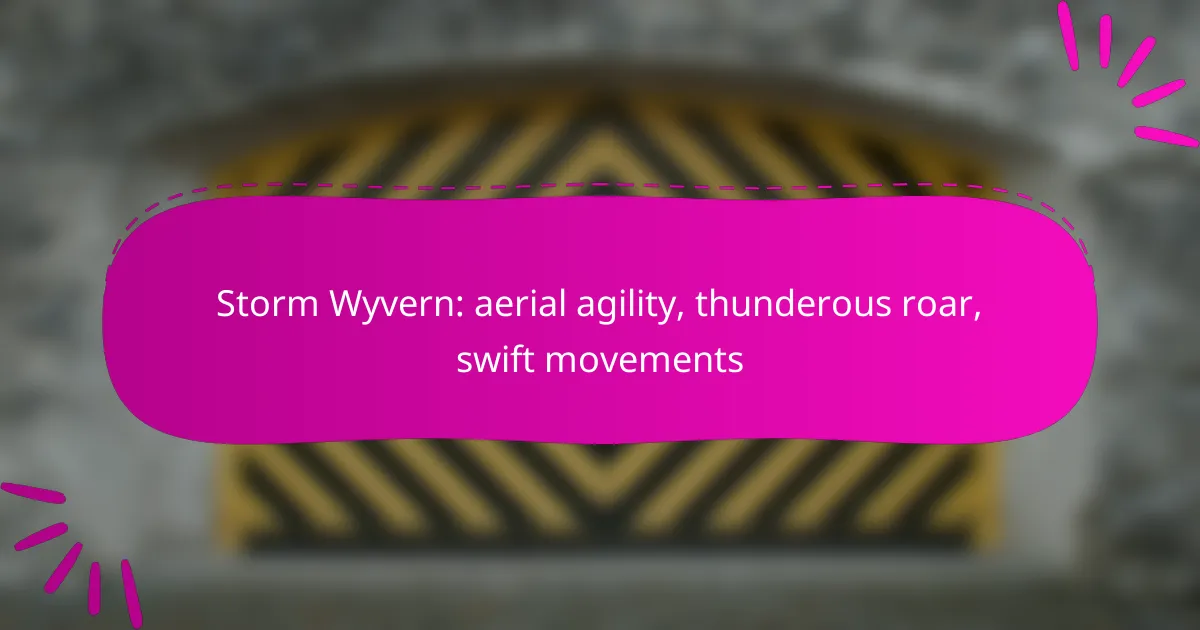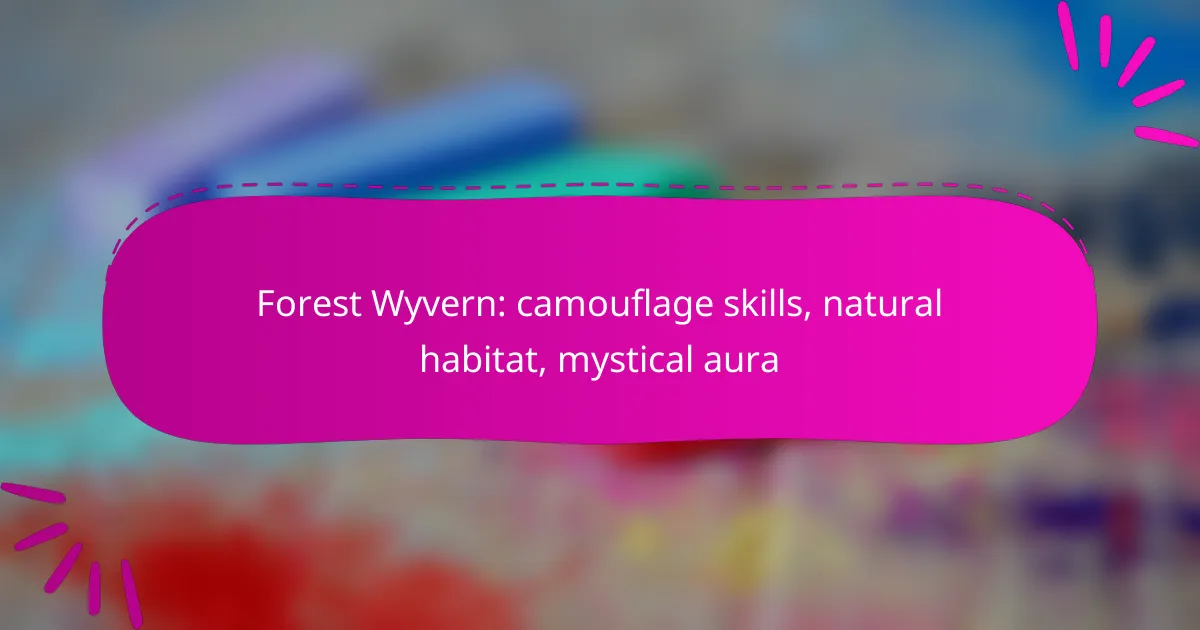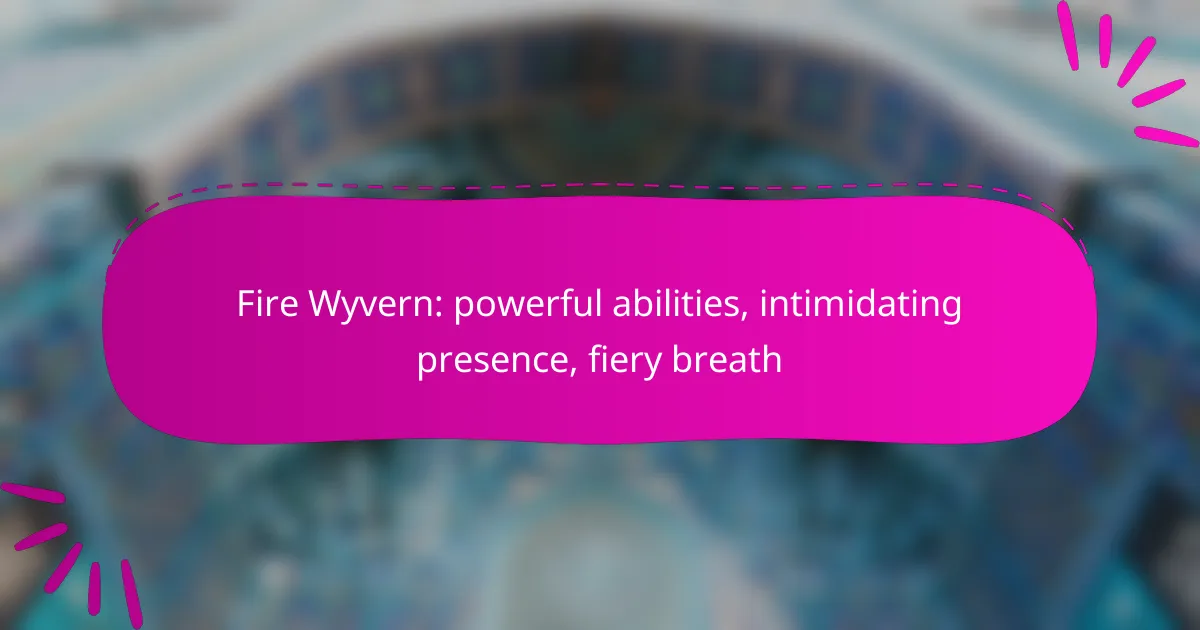The Storm Wyvern is a master of aerial agility, showcasing remarkable maneuverability through advanced flight techniques and optimized wing designs. Its thunderous roar not only intimidates potential threats but also serves as a means of communication within its territory. With swift movements, the Storm Wyvern adeptly navigates its environment, enhancing its survival and hunting success.
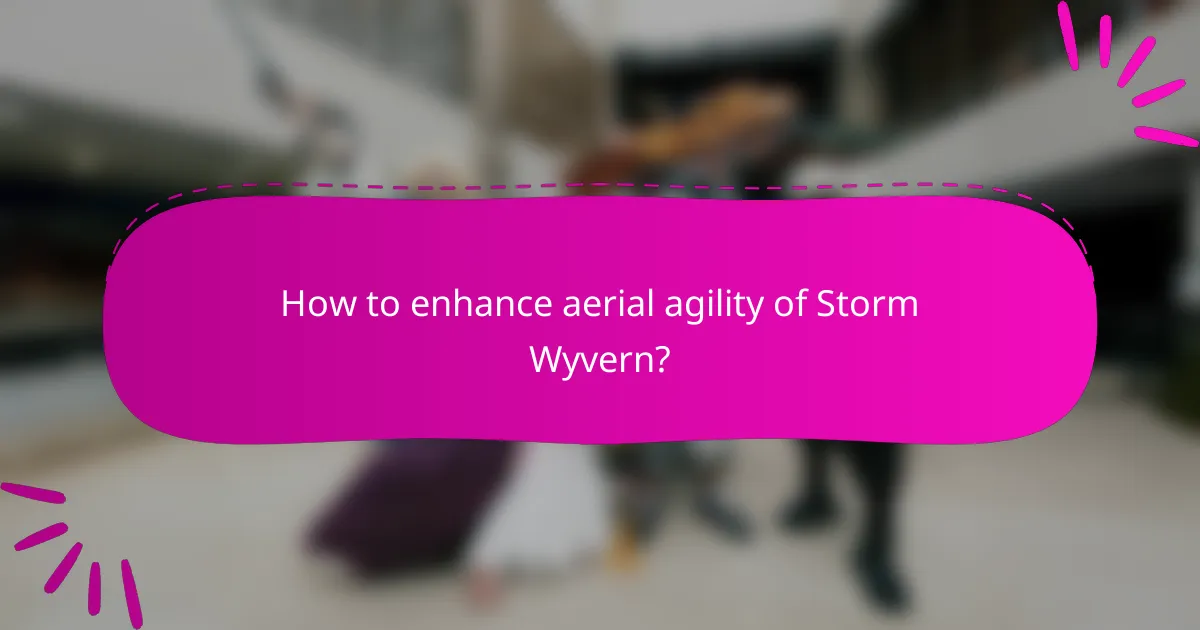
How to enhance aerial agility of Storm Wyvern?
To enhance the aerial agility of Storm Wyvern, focus on advanced flight training, lightweight materials, and optimized wing design. These strategies improve maneuverability and responsiveness, allowing for swift movements and sharp turns.
Use advanced flight training techniques
Implementing advanced flight training techniques is crucial for enhancing the aerial agility of Storm Wyvern. Techniques such as precision maneuvers and rapid ascent drills can significantly improve responsiveness in the air.
Consider using simulation tools to practice complex aerial patterns. This allows for safe experimentation with various flight styles, helping pilots learn how to react quickly during actual flights.
Incorporate lightweight materials
Utilizing lightweight materials is essential for improving the Storm Wyvern’s agility. Materials such as carbon fiber and advanced composites reduce overall weight, enhancing speed and maneuverability.
When selecting materials, aim for a balance between strength and weight. For instance, using a combination of lightweight metals and synthetic fibers can provide the necessary durability while keeping the aircraft nimble.
Optimize wing design for maneuverability
Optimizing the wing design is a key factor in enhancing the aerial agility of Storm Wyvern. Wings with a higher aspect ratio can improve lift and reduce drag, allowing for quicker turns and ascents.
Consider incorporating features like winglets or variable geometry wings, which can adjust during flight to enhance performance. Testing different designs in wind tunnels can provide valuable insights into the most effective configurations for agility.

What are the benefits of a thunderous roar?
A thunderous roar provides several advantages for a storm wyvern, primarily serving as a tool for intimidation and communication. This powerful vocalization can deter potential threats and establish dominance within their territory.
Intimidates predators and rivals
The thunderous roar of a storm wyvern acts as a formidable warning to both predators and rivals. This loud sound can signal strength and ferocity, often causing other creatures to think twice before approaching. In many cases, a single roar can be enough to scare off smaller predators or competing wyverns.
Additionally, the roar can be a strategic advantage during territorial disputes. By demonstrating their vocal prowess, storm wyverns can assert their claim over an area without engaging in physical confrontation, which could lead to injury.
Enhances communication with other wyverns
Communication among storm wyverns is crucial for social interactions, and a thunderous roar plays a key role in this. It can convey various messages, such as alerts about danger or signals for mating. The intensity and frequency of the roar can indicate urgency or emotional state, facilitating better understanding among wyverns.
Moreover, the roar can help maintain group cohesion during flight or hunting. By using their vocalizations, storm wyverns can coordinate movements and ensure that all members of the group are aware of their surroundings, enhancing their overall effectiveness as a team.

How do swift movements improve survival?
Swift movements significantly enhance survival by enabling creatures to evade threats and effectively pursue prey. This agility allows them to navigate their environment quickly, making them less vulnerable to larger predators and increasing their chances of successful hunting.
Evades attacks from larger creatures
Swift movements allow smaller creatures, like the Storm Wyvern, to dodge attacks from larger predators. By utilizing rapid directional changes and aerial maneuvers, they can avoid being targeted, which is crucial for survival in the wild. For instance, a quick ascent or dive can put distance between the wyvern and a pursuing beast.
Additionally, the ability to swiftly change altitude and direction can confuse larger attackers, making it harder for them to land a hit. This agility is often the difference between life and death in predator-prey interactions.
Increases hunting success rates
Swift movements not only aid in evasion but also enhance hunting efficiency. The Storm Wyvern can quickly close the distance on its prey, catching them off guard with sudden bursts of speed. This element of surprise is vital for successful hunts, especially when targeting agile or elusive animals.
Moreover, rapid movements allow the wyvern to adapt to the behavior of its prey, making it easier to predict and intercept their escape routes. This adaptability can lead to higher success rates during hunts, ensuring a steady food supply.

What equipment enhances Storm Wyvern performance?
To optimize the performance of a Storm Wyvern, specific equipment is essential. The right gear can significantly improve its aerial agility, enhance its thunderous roar, and support its swift movements.
High-performance flight harness
A high-performance flight harness is crucial for maximizing the Storm Wyvern’s agility in the air. This harness should be lightweight yet sturdy, allowing for quick maneuvers without hindering movement. Look for materials that offer both durability and flexibility, ensuring the wyvern can execute sharp turns and rapid ascents.
When selecting a harness, consider features such as adjustable straps for a secure fit and padding for comfort during extended flights. A well-fitted harness can reduce fatigue, enabling the wyvern to maintain its speed and responsiveness over longer periods.
Durable wing membranes
Durable wing membranes play a vital role in enhancing the Storm Wyvern’s flight capabilities. These membranes should be crafted from high-strength materials that can withstand harsh weather conditions while providing optimal lift. Look for membranes that are both lightweight and resistant to tears, ensuring longevity and performance.
In addition to material quality, consider the membrane’s design, which should promote aerodynamic efficiency. Membranes that allow for slight adjustments can help the wyvern adapt to different flying conditions, enhancing its overall agility and control during flight.

What are the best habitats for Storm Wyverns?
Storm Wyverns thrive in habitats that provide both aerial space and access to prey. Ideal environments include mountainous regions with open skies and forested areas rich in wildlife.
Mountainous regions with open skies
Mountainous areas offer Storm Wyverns the elevation and wide-open spaces they need for their aerial agility. These regions allow for swift movements and quick maneuvers, essential for hunting and evading threats.
High altitudes provide Storm Wyverns with vantage points to spot prey from a distance. The combination of rugged terrain and clear skies enhances their ability to soar and dive, making these habitats particularly favorable.
Forested areas with ample prey
Forested regions are beneficial for Storm Wyverns due to the abundance of prey such as small mammals and birds. These areas provide cover for ambushing and stalking, allowing the wyverns to utilize their stealth and agility effectively.
While dense foliage may limit aerial movement, it offers strategic advantages for hunting. Storm Wyverns can navigate through trees and use the environment to their advantage, ensuring a steady food supply.

How to care for a Storm Wyvern?
Caring for a Storm Wyvern involves providing a suitable diet and ensuring ample opportunities for exercise. Proper care will help maintain its health and agility, crucial for this majestic creature.
Provide a balanced diet of fresh meat
A Storm Wyvern thrives on a diet rich in fresh meat, which is essential for its energy and overall well-being. Suitable options include large game such as deer, boar, or even smaller livestock, depending on availability.
Ensure that the meat is free from contaminants and preferably sourced from reputable suppliers. Regularly rotating the types of meat can prevent dietary deficiencies and keep the wyvern interested in its meals.
Ensure regular exercise and flight
Regular exercise is vital for a Storm Wyvern to maintain its aerial agility and strength. Allowing the wyvern to fly freely for several hours each day is recommended, as this mimics its natural behavior and keeps it physically fit.
In addition to flight, incorporating agility training can enhance its swift movements. Setting up obstacle courses or engaging in playful activities can stimulate both its mind and body, ensuring a well-rounded exercise routine.
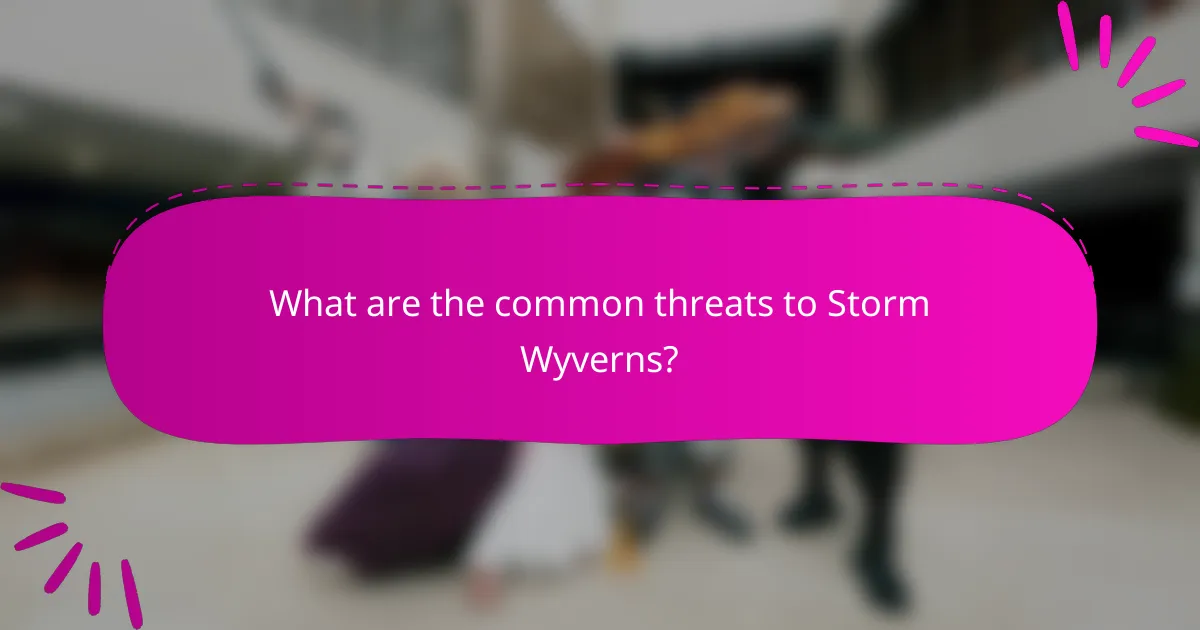
What are the common threats to Storm Wyverns?
Storm Wyverns face several significant threats that impact their survival and habitat. The most pressing issues include habitat destruction, climate change, and human interference, which collectively disrupt their natural behaviors and ecosystems.
Habitat destruction
Habitat destruction poses a critical threat to Storm Wyverns, as it directly reduces their living space and access to resources. Activities such as deforestation, urban development, and agricultural expansion lead to the loss of forests and mountainous regions where these creatures thrive.
As their habitats shrink, Storm Wyverns may struggle to find adequate nesting sites and food sources, which can lead to declining populations. Conservation efforts must focus on protecting these vital areas to ensure the survival of the species.
To mitigate habitat destruction, it is essential to promote sustainable land-use practices and establish protected areas. Engaging local communities in conservation initiatives can also foster a sense of stewardship and reduce the impact of human activities on these majestic creatures.






